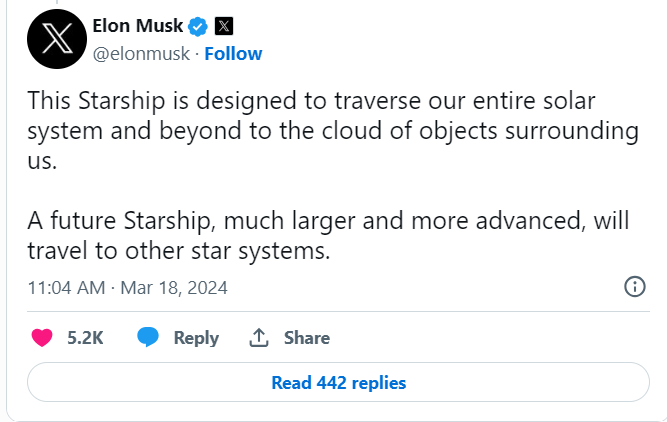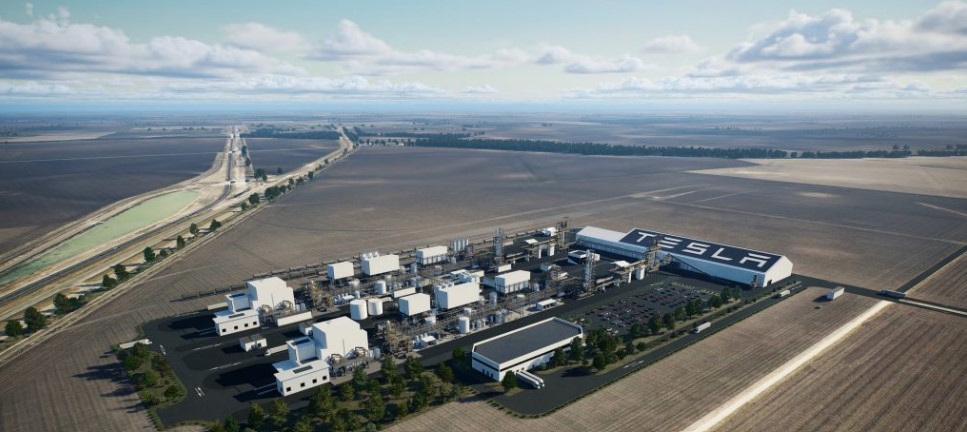SpaceX Starship spacecraft and Super Heavy rocket are known together as Starship. It embodies a revolutionary reusable transport system engineered to ferry crew and cargo to various destinations such as Earth orbit, the Moon, Mars, and beyond. Starship stands as the most potent launch vehicle ever conceived, boasting the capacity to transport up to 150 …
SpaceX Starship: Revolutionizing Space Travel

SpaceX Starship spacecraft and Super Heavy rocket are known together as Starship. It embodies a revolutionary reusable transport system engineered to ferry crew and cargo to various destinations such as Earth orbit, the Moon, Mars, and beyond. Starship stands as the most potent launch vehicle ever conceived, boasting the capacity to transport up to 150 metric tonnes in its reusable configuration and an impressive 250 metric tonnes when expendable.
SpaceX’s Vision
SpaceX’s Starship project is a ground-breaking endeavor to transform space travel. Starship’s two unique designs, one for cargo and one for astronauts promise to change our notion of space exploration.

Cargo Configuration
Starship’s cargo design has a payload fairing that measures 9 meters (30 feet) across at its widest point. This configuration enables Starship to transport payloads up to 22 meters (72 feet) tall, making it the launch vehicle with the highest payload volume. The potential is enormous, with the ability to deploy space telescopes far larger than the James Webb Space Telescope, which launched folded up due to its size.
Astronauts on Board
The crew configuration of a spaceship can seat up to 100 astronauts, providing an exciting prospect for manned voyages beyond Earth’s orbit. This arrangement represents a substantial advancement in human spaceflight capabilities.
Launch Sites and Testing
SpaceX began testing Starship in Boca Chica, Texas, in 2019. The original experiments used a small low-altitude prototype called Starhopper, which successfully demonstrated its capabilities by reaching an altitude of 150 meters (500 feet) before landing on a separate landing platform. Subsequent tests with full-size Starship prototypes began in 2020 despite difficulties, including many prototype explosions during or after landing attempts.
Despite failures, SpaceX scored a crucial milestone in May 2021 with the successful launch of Starship SN15, which reached an altitude of 10 km (6 miles) before landing softly on Earth. However, successive orbital test flights met difficulties, yielding variable degrees of success and failure.
Towards Lunar Exploration
SpaceX plans to deploy Starship for ambitious lunar exploration missions. Plans call for a flight around the Moon with Japanese entrepreneur Maezawa Yusaku and a team of artists. Furthermore, Starship will play an important part in NASA’s Artemis III project, which aims to return humans to the Moon’s surface for the first time since the Apollo program.
Getting Starship ready to take astronauts into deep space will require a lot more work and many more test flights. Making a version that can travel between stars will require an even bigger jump, something that’s hard to imagine right now.

Elon Musk’s Mars Vision
Mr. Musk has long expressed his desire to colonize Mars, and at the same conference last year, he finally revealed engineering details: a massive reusable rocket called the Interplanetary Transport System.
“History is going to bifurcate in two directions. One path is we stay on Earth forever, and then there will be some eventual extinction event,” Musk.
Fuel and Marine Concerns
When SpaceX’s Starship upper stage recently crashed into the Indian Ocean, questions arose about its environmental impact. Starship uses liquid oxygen and liquid methane, which are relatively eco-friendly fuels. However, dumping debris into the ocean remains a concern.
Experts are concerned about Elon Musk’s ambitions to raise Starship launches to potentially hundreds per year. These frequent launches may result in a considerable rise in reentering satellites and rocket stages, raising worries about the environmental impact.
Greenhouse Gas Emissions
While methane combustion emits fewer greenhouse gases than burning oil or coal, it does contribute to the greenhouse impact. Each Starship launch generates a significant amount of carbon dioxide equivalent, which contributes to global warming.
Additional Environmental Concerns
Starship launches emit water vapor and soot, which have environmental concerns. Water vapor at high altitudes and soot in the upper atmosphere can contribute to increased warming. Starship launches also leak methane, a strong greenhouse gas, raising environmental worries.
The environmental impact of manufacturing Starship vehicles at SpaceX’s facilities adds another layer of complexity. Accounting for the greenhouse gases emitted during manufacturing is challenging but essential to understand Starship’s environmental footprint comprehensively.
Interesting Facts about SpaceX’s Starship
Starship was launched for the first time in 2023, resulting in a massive explosion similar to a volcanic eruption and the release of huge concrete debris. The incident was eye-opening for Philip Metzger as he stated, “It was eye-opening to us that launch pads could explode so violently,” emphasizing the need for improved safety measures and engineering solutions in space exploration.
- At launch, Starship sits atop a rocket called Super Heavy, forming a combined system standing 120m (394ft) tall.
- The spacecraft is equipped with six highly efficient Raptor engines developed by SpaceX over a decade, with a design that minimizes propellant waste during combustion.
- Methane (CH4) and liquid oxygen (O2) are propellants, with methane as fuel and oxygen as oxidizers.
- Elon Musk envisions synthesizing methane from Martian resources using a process called the Sabatier reaction, enabling the refueling of Starship for return trips to Earth.
- Starship’s payload compartment, located towards the front of the spacecraft, is capable of hauling large cargo or people to destinations in deep space.
- With around 33 Raptor engines, Starship is expected to achieve more than 70 Meganewtons (16 million lbs) of maximum thrust.
- Super Heavy, with its impressive payload capacity of at least 100 tonnes to low-Earth orbit, surpasses the power of the Saturn V launcher used in the Apollo Moon missions.
- Super Heavy’s design uses 3.5 tons of oxygen for every ton of fuel. This means it mostly has liquid oxygen when it goes up, unlike the Falcon rocket before it.
Revolutionizing Telecommunications
SpaceX has reached an important milestone in the telecommunications industry by using its Starlink Direct-to-Cell (DTC) satellites to publish the first social media post on X. This accomplishment demonstrates its commitment to modernizing global telecommunications. Surprisingly, this achievement was performed with a basic cell phone without specialist equipment. SpaceX’s DTC project aims to remove cellular dead zones worldwide by offering regular LTE service directly to ground-based cell phones via its constellation of low Earth orbit satellites.
The recent social media post, featuring a captivating image of the Santa Cruz Mountains in California, showcased the technological prowess and demonstrated the potential of Starlink’s DTC service to overcome natural obstacles like heavy tree cover, which typically pose challenges for satellite communications. This demonstration underscores the feasibility of SpaceX’s innovative approach to global telecommunications, promising enhanced connectivity even in areas with challenging terrain.
Subscribe to Our Newsletter
Keep in touch with our news & offers










